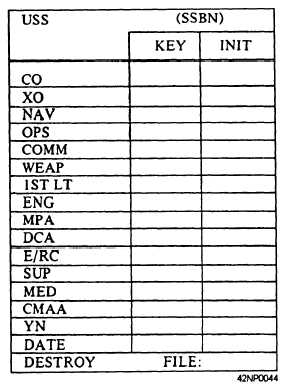| |
loose-leaf binder, a file folder, or a two-post clipboard.
These logs consist of the second carbon copy of the
Correspondence/Material Control Form, OPNAV
5216/10. Control forms are filed numerically by
activity control number (ACN).
Outgoing Mail Log
An outgoing mail log is maintained for material
transmitted via certified or registered mail (including
registered guard mail and Confidential or unclassified
material when sent via certified/registered mail). This
log is maintained by one of your command’s Yeomen
and should contain the following information on each
piece of mail that is dispatched:
Registry/certified number
Contents
Addressee
Signature of person preparing item for mailing
Date and time of delivery to GMPO
Signature of GMPO to whom delivered
The purpose of the outgoing mail log is to have a
chronological record of all outgoing material from the
command whether the material is sent via registered or
certified mail. Top Secret material is transmitted by the
Defense Courier Service (DCS) and other authorized
individuals as specified in chapter 15 of Department of
the Navy Information and Personnel Security Program
Regulation, OPNAVINST 5510.1.
RECEIPT PROCEDURES
Normally, designated YNs or PNs receive all
incoming mail except Top Secret. All of the
commanding officer’s mail should be opened upon
receipt, and a quick check made for correspondent that
deserves immediate attention. When registered mail is
received at your command, log receipt of this mail in
the GMPO log.
When the designated YN or PN has opened the
incoming mail and determined that it is unclassified,
he/she must sort it into two categories—routing without
a route slip or routing with OPNAV Form 5216/10.
Unclassified Correspondence
For unclassified mail not requiring control, a rubber
stamp (fig. 4-3) with check boxes is used for routing.
Figure 4-3.—Sample routing stamp.
Thus, the correespondence itself bears a complete record
of individuals who have to see it.
Most commands have their own routing stamp.
This stamp shows a command’s internal departmental
structure and is similar to the one shown in figure 4-3.
Control Mail
Mail to be controlled is routed using the OPNAV
Form 5216/10 (fig. 4-1). Mail to be controlled may
consist of unclassified mail that requires action, mail of
historical importance to the command, and mail that has
future reference value.
Confidential and Secret Correspondence
Confidential correspondence may be divided into
two categories:
1.
2.
Noncontrolled Confidential mail, which
provides general information and does not
require a reply and for which routing is
accomplished by the use of a rubber stamp.
Controlled Confidential mail, which requires
action, has historical importance, or future
reference value.
4-5
|

